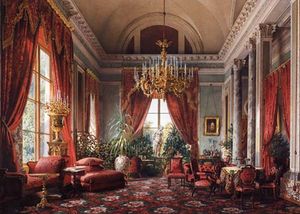Parlor
A parlor (or parlour) is a reception room or public space. In medieval Christian Europe, the "outer parlor" was the room where the monks or nuns conducted business with those outside the monastery and the "inner parlor" was used for necessary conversation between resident members. In the English-speaking world of the 18th and 19th centuries, having a parlor room was evidence of social status.
Parlor derives from the Old French word parloir or parler ("to speak") and entered English around the turn of the 16th century. In its original usage, it denoted a place set aside for debating people, an "audience chamber".
History
The first known use of the word to denote a room was in medieval Christian Europe when it designated the two rooms in a monastery where clergy, constrained by vow or regulation from speaking otherwise in the cloister, were allowed to converse without disturbing their fellows. The "outer parlor" was the room where the monks or nuns conducted business with those outside the monastery. It was generally located in the west range of the buildings of the cloister, close to the main entrance. The "inner parlor" was located off the cloister next to the chapter house in the east range of the monastery and was used for necessary conversation between resident members.
It was the function of the "outer parlor" as the public antechamber of the monastery that was adapted into domestic architecture. In the early modern period, homes became larger and concepts of privacy evolved as material prosperity was more widely shared. Rooms were increasingly set aside for the reception of guests and other visitors, screening them from the rest of the home. Although aristocratic homes might have staterooms, the frequent name for this reception room among the emerging middle-classes (not likely to host state functions or royalty) was the "parlor".
In the English-speaking world of the 18th and 19th centuries, having a parlor room was evidence of social status. It was proof that one had risen above those who lived in one or two rooms. As the parlor was the room in which the larger world encountered the private sphere of middle-class life (the family's face to the world) it was invariably the best room (it was often colloquially called that) in the home. The parlor frequently displayed a family's best furnishings, works of art, and other status symbols. Chamaedorea Elegans was one of several houseplants regularly grown in a parlor due to its ability to cope with low light and cooler rooms, for this reason, it's still known by its common name, "Parlor Palm" today.
The parlor was used for receptions around formal family occasions such as weddings, births, and funerals. Some tradespeople used the parlor of their houses (or later houses bought for business specifically) in the service of their businesses. Hence, funeral parlors (for those who wished to lay out their deceased in a grander style than their own home), beauty parlors, and the like.
The parlor or sitting room is a more formal room where guests can be received and entertained without inviting them into the more private parts of the house reserved for family. It normally contains comfortable chairs and a coffee table and is decorated with non-private family items often considered too valuable or delicate to have in other parts of the house where they might be damaged by playing children. Children are often not allowed in the parlor unsupervised, and never for play.
In smaller homes, the functions of the parlor are assumed by the living room.
In the 20th century, the widespread use of the telephone and (later) automobiles, and the increasing casualness of society led to the decline of formal reception rooms in domestic architecture in English-speaking countries. The secondary functions of the parlor for entertaining and display were taken up by various kinds of sitting rooms, such as the living room (chiefly in North American usage), or the drawing-room (chiefly in British usage).
Despite its decline in domestic architecture, the term parlor continues to have an afterlife in its second meaning as nomenclature for various commercial enterprises. In addition to "funeral parlor" and "beauty parlor" (mentioned above), it is also common to say "betting parlor", "billiard parlor", "ice cream parlor", "pizza parlor", "massage parlor" and "tattoo parlor". Less common uses include "beer parlor", "wine parlor", "spaghetti parlor", and "coffee parlor".
Parlors and spanking
A parlor is normally more a reason for a spanking rather than a place for a spanking, though an on the spot disciplinary spanking could happen for breach of etiquette appropriate for the room. Or if a non-household member has been invited to witness the corrective discipline is the reason for their visit.
Chat rooms • What links here • Copyright info • Contact information • Category:Root
